With many of Washington, D.C.’s museums closed due to COVID, we recently decided to stay in northern Virginia rather than in D.C. itself so that we could be close to other attractions that were open.
One of places we’d wanted to visit was George Washington’s Mount Vernon, so we were pleased to see that they were open. Having now visited, we’re even more pleased that they were open because it was a fascinating place which is definitely worth visiting.
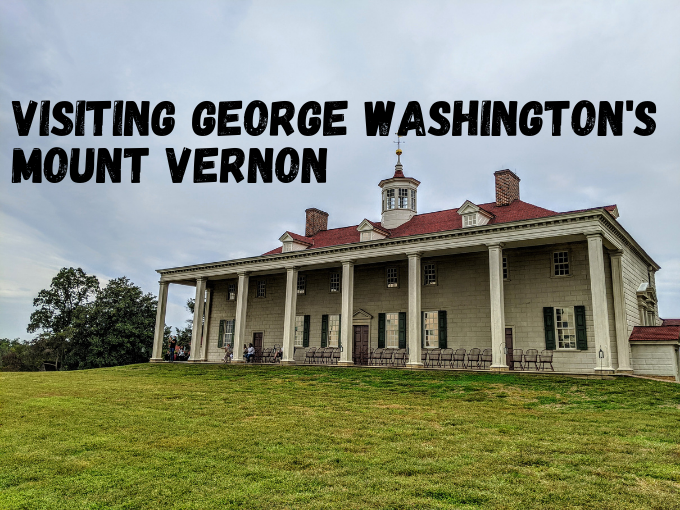
Mount Vernon once covered 8,000 acres, 3,200 of which were under crop. The present day estate still covers approximately 500 acres, so they weren’t restricting the number of grounds passes being sold as there was so much space to be able to safely socially distance.

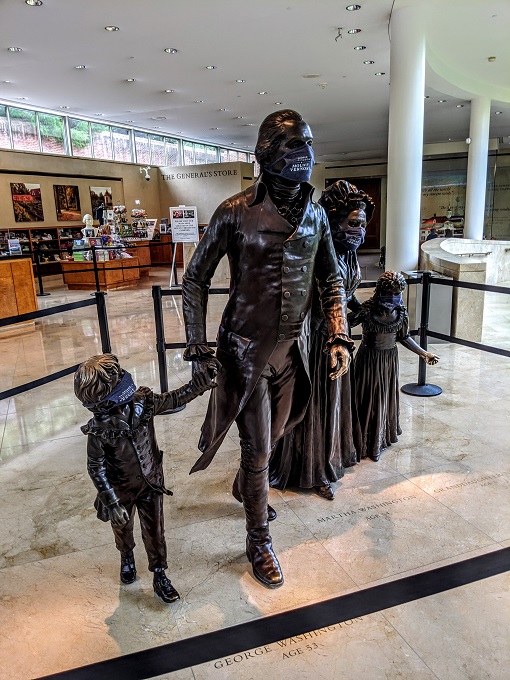
Having said that, you have to buy a timed ticket to take a mansion tour as they’re limiting the number of people on each tour due to pandemic-related safety reasons.
The grounds of Mount Vernon are pet-friendly, but dogs aren’t allowed inside any of the buildings. We brought Truffles along with us for the day, so Shae went on a tour of the house first while I waited outside with Truffles, then I went on the next tour while Shae waited outside with her. I think Truffles might be slightly sticking her tongue out in the photo below because she wanted to explore the mansion too but didn’t get to do that.
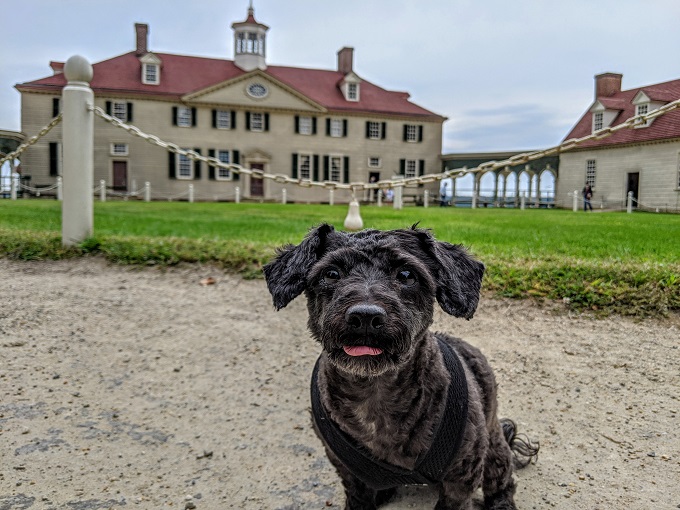
The mansion tours seem to run a little differently depending on your tour guide. Shae’s guide did her talk entirely outside of the house to reduce the number of water droplets inside, while my guide gave the tour as we walked around inside.
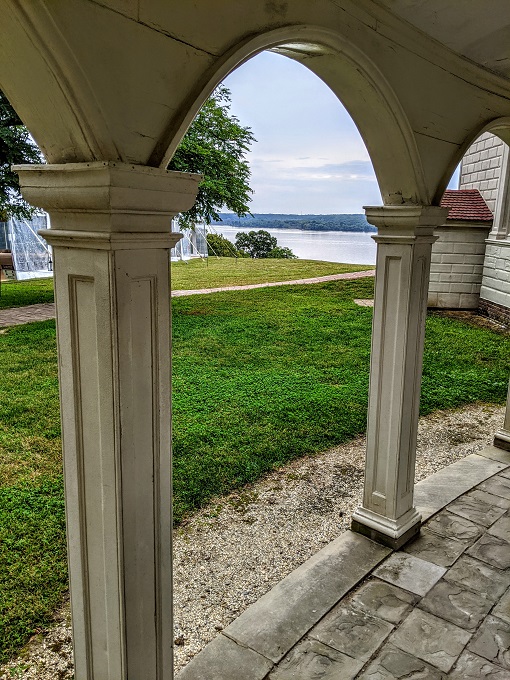
Mount Vernon began as a 1.5 story building before being built up over the years to eventually incorporate 21 rooms. My guide advised that it would’ve started off looking a little bit like the kitchen which is adjacent to home (see the photo below), so quite a difference from how the mansion looks now.
Seeing as the homes were built pre-air-conditioning, the windows on the top floor would be opened during the summer to help circulate air through the home.
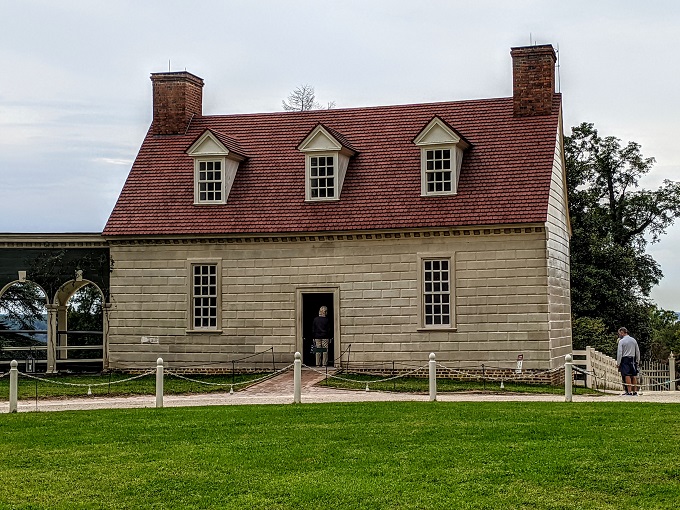
You start off in the salon room which was also known as the “show-off” room. This was generally only used for special occasions, although it’s still used today at times. When President Macron of France visited in 2018, he took a tour of Mount Vernon with President Trump. They were due to have dinner outside, but the weather had other ideas, so dinner was moved into the salon room instead.
There was harpsichord music playing while we walked through, although the harpsichord currently in the room is a reproduction piece rather than one that George Washington originally owned.
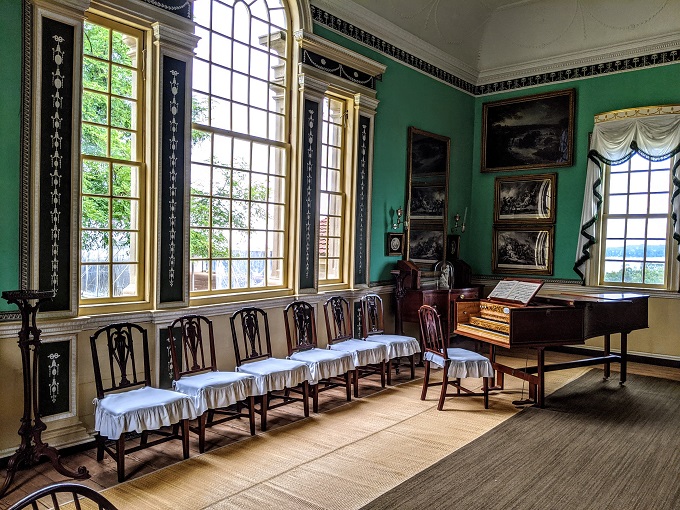
Some of the pieces in the mansion are original though. For example, in 1797 the Marquis de Lafayette gave George Washington the key to the Bastille in France and that’s still hanging on the wall in the mansion today.
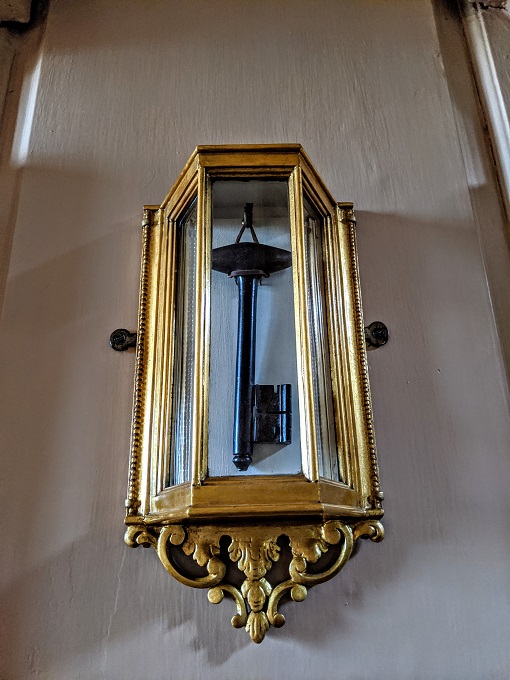
There are nine bedrooms in the 21 room mansion, with four poster beds in seven of the bedrooms. The photo below is from one of the guest bedrooms in the home.
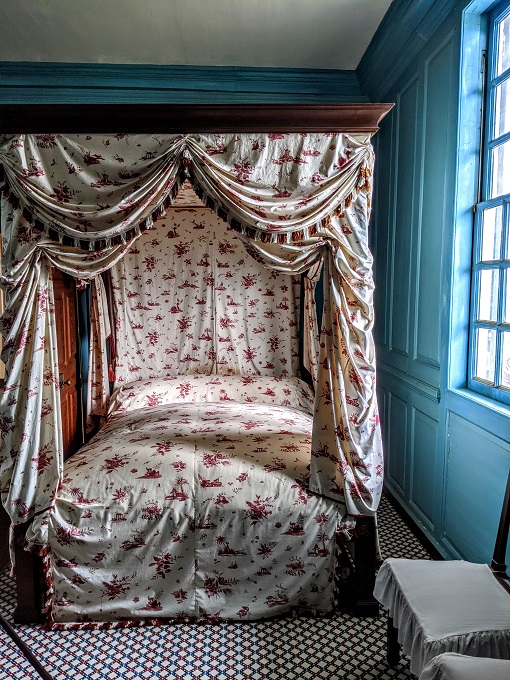
The tour also takes you through George Washington’s study/library.
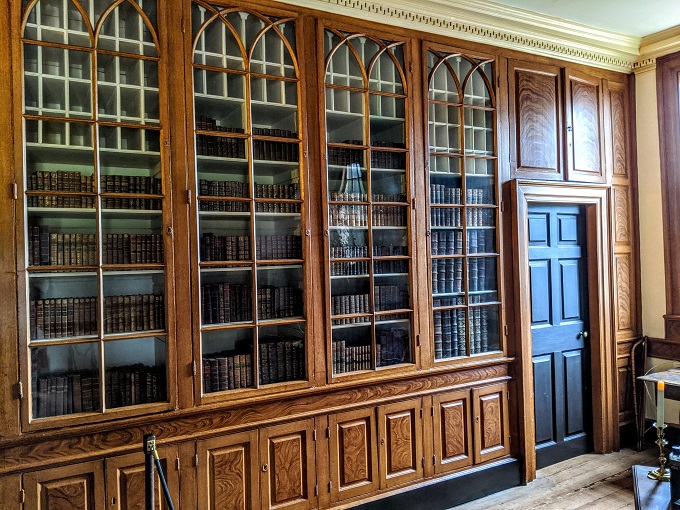
The study/library contained Washington’s specially designed fan chair. Having lived there seven years before setting off on our 5 year, 50 state road trip, Virginia can get uncomfortably hot and humid in the summer. The fan chair was powered by Washington pedaling with both legs to provide a breeze by blowing the overhead flap back and forth.
Also on the desk were the types of turkey quills that he would’ve written with.
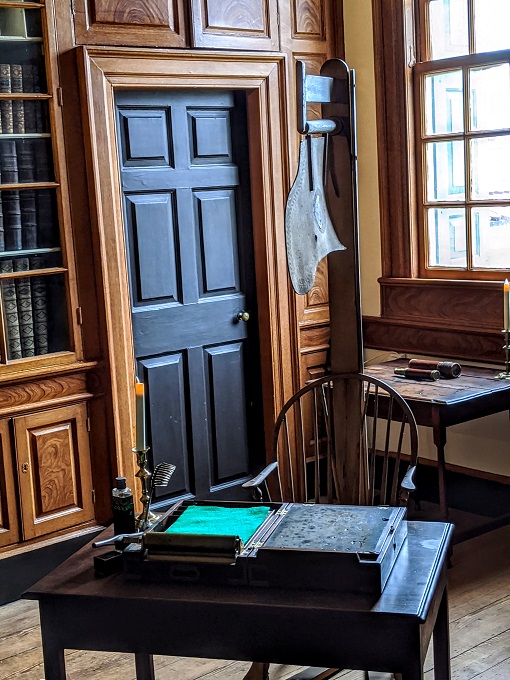
After walking through the butler’s pantry, we found ourselves in the dining room. The vibrant green is its original color.
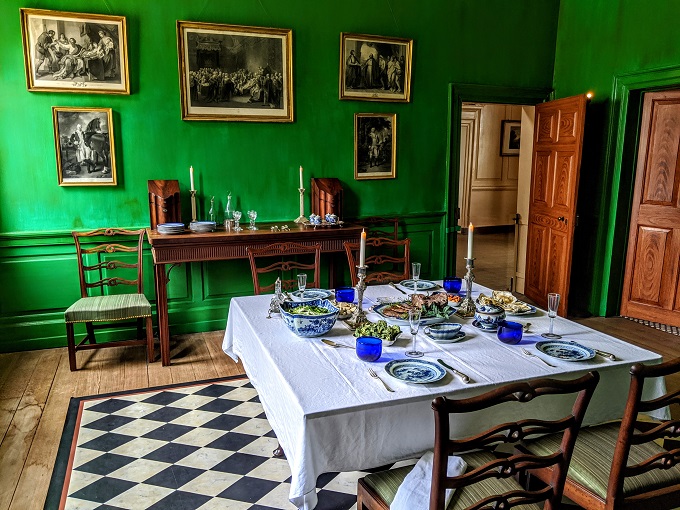
The tour finished outside at the other end of the mansion. My tour guide pointed out a tree in the distance which was a Blue Atlas Cedar. It’s thought that the tree was planted after George Washington passed away as he wouldn’t have wanted to obstruct his view of the river.
Despite the fact that Mount Vernon is in Virginia, if you step into the river then you’re suddenly in Maryland. Where rivers split other states, the official border between the states is usually halfway across the river. Maryland owns much of the Potomac River though, so it bumps up against Mount Vernon’s property line.
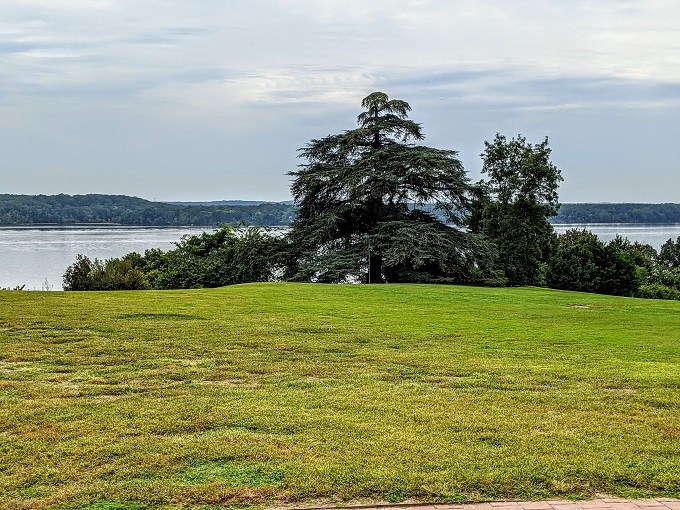
Just before the tour ended, we walked through the kitchen. This was kept separate in a separate building to the main mansion to ensure the home didn’t get too hot.
Over the mantlepiece were what looked like épées (swords used in fencing), but were actually used as rotisserie sticks.
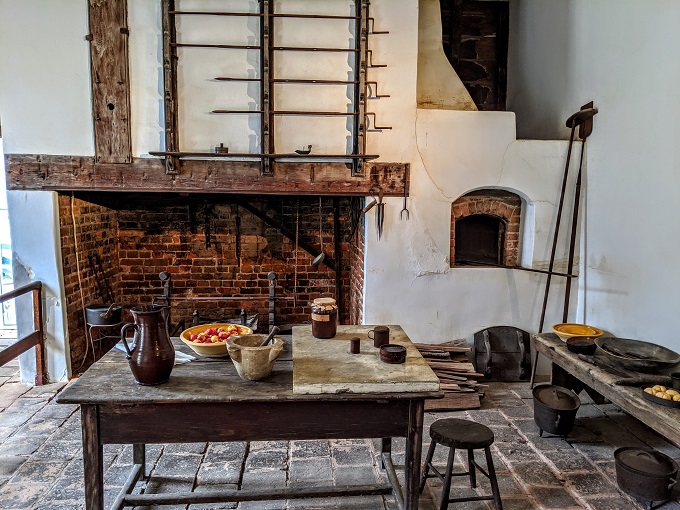
On the other side of the kitchen was a smaller separate room where food would be stored, including smoked meats which would be hung on the hooks. Martha Washington wanted a ham a day, so the smokehouse (seen later) was used for up to 400 hams per year.
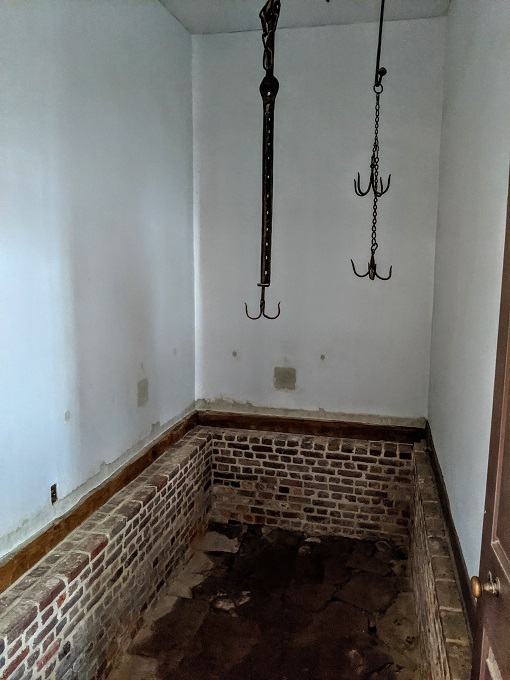
My guide shared an interesting little tidbit just after our tour finished. Mount Vernon was originally called Little Hunting Creek, but Washington renamed it Mount Vernon in honor of the English naval officer Admiral Edward Vernon who he served under.
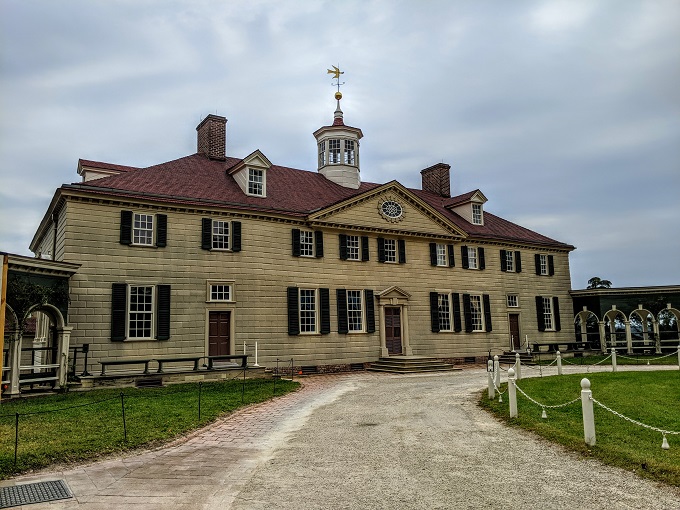
Another interesting fact is that despite the home looking like it’s made of stone, it’s actually made of wood which is made to look like stone through a process called rustication.

Once my tour was done, I met back up with Shae and Truffles and we had our lunch. The back side of Mount Vernon’s mansion has a row of chairs where you can sit and relax while looking out over the Potomac River.
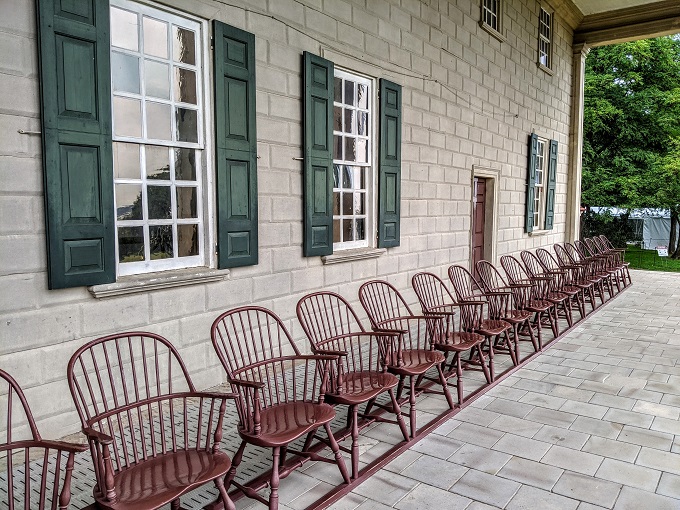
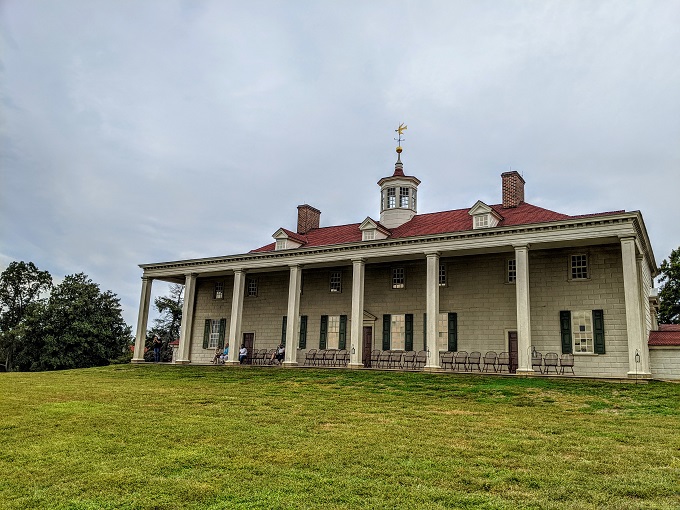
Once we were done eating, we explored the grounds of Mount Vernon as there was so much else to see.
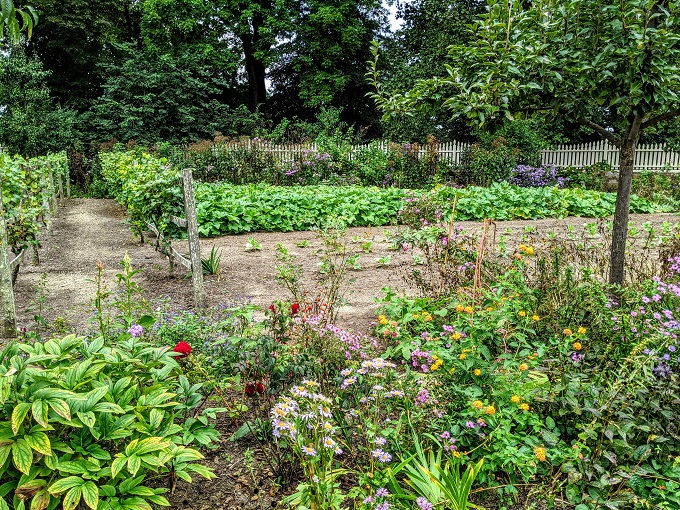
There are many buildings around the grounds which are set up to show how they would’ve been used back in the day.
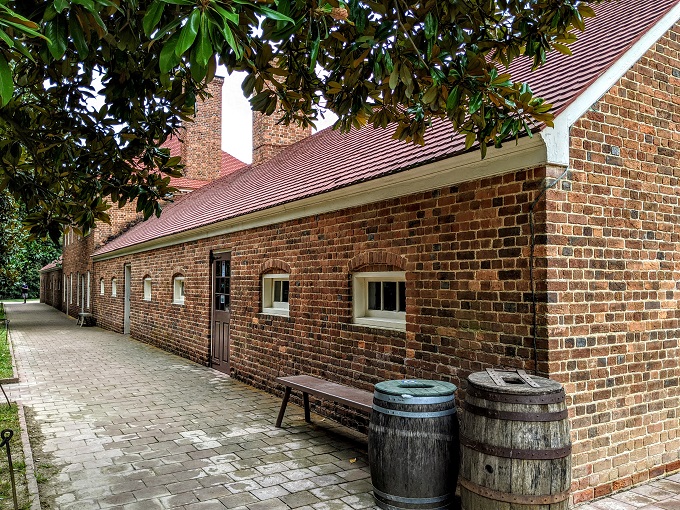
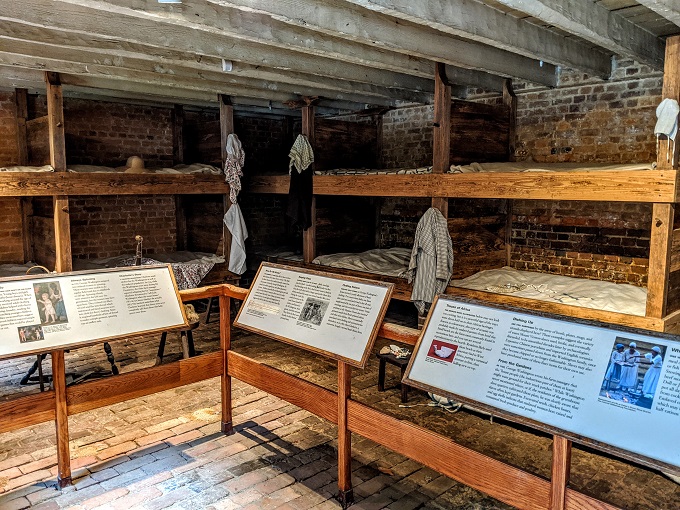
Due to COVID, some of the exhibits were closed off, so you had to look at them from a distance rather than being able to enter the buildings.
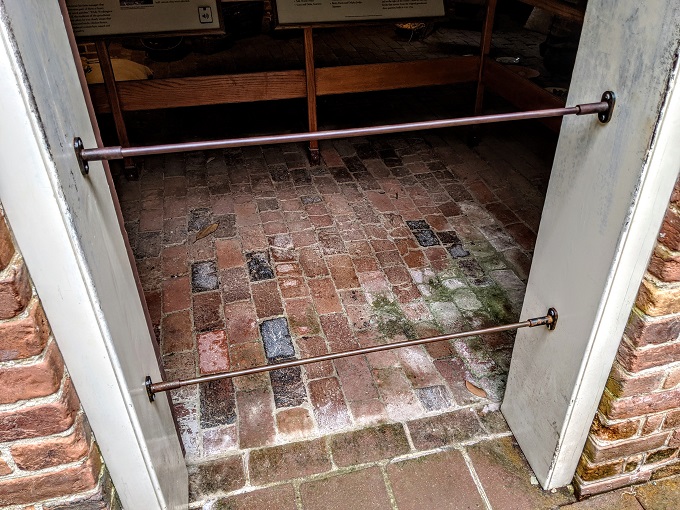
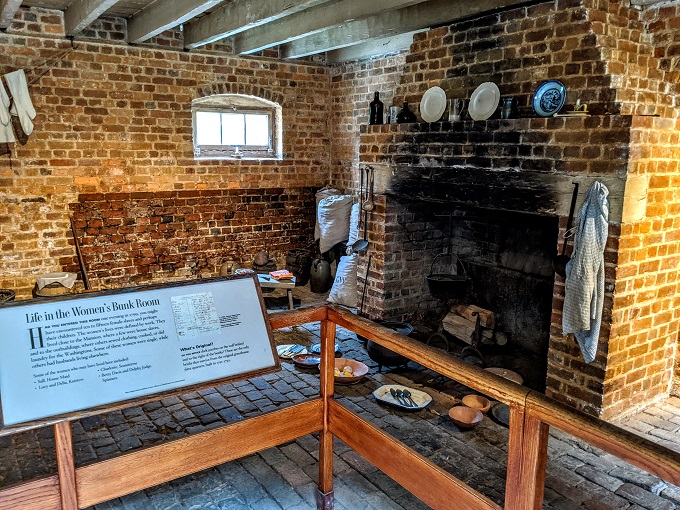
There are a number of other standalone buildings located close to each other as you walk around.
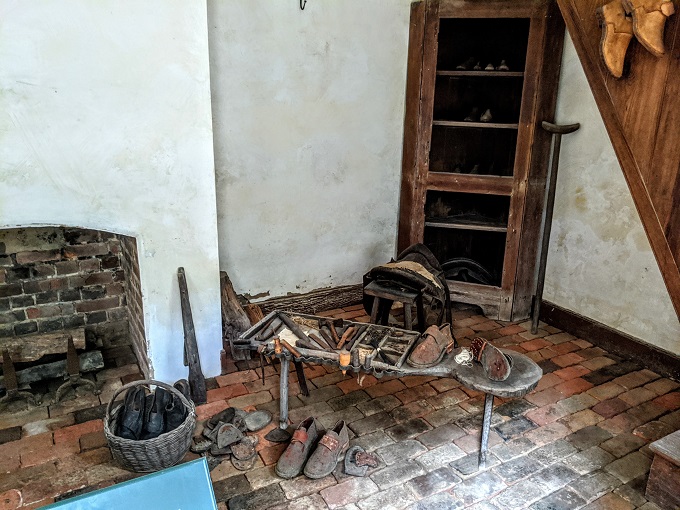

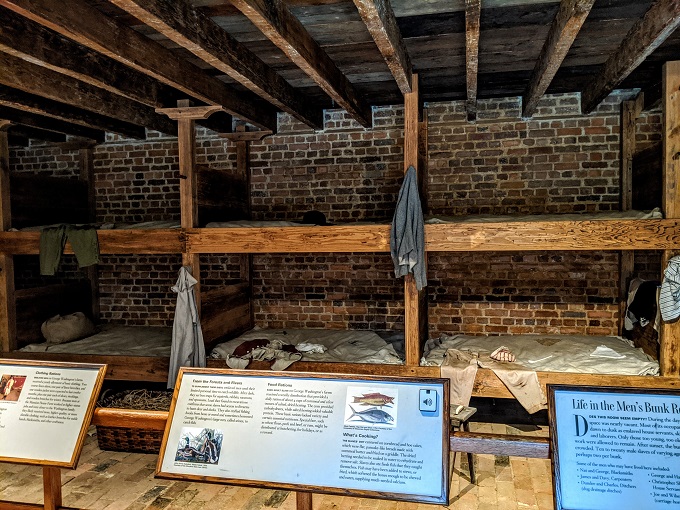
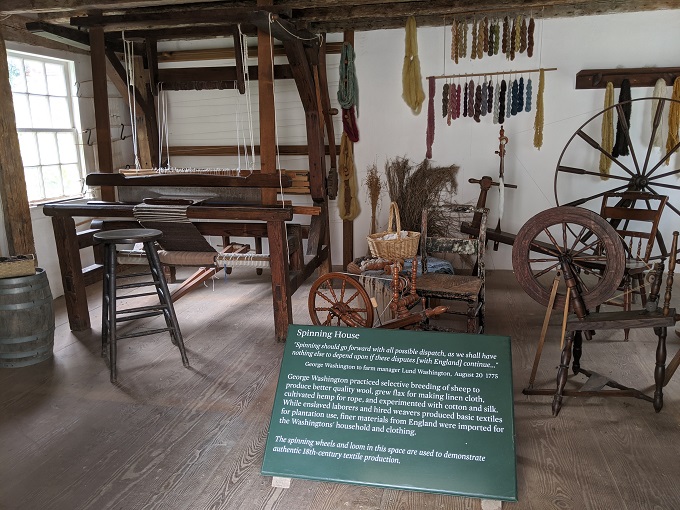
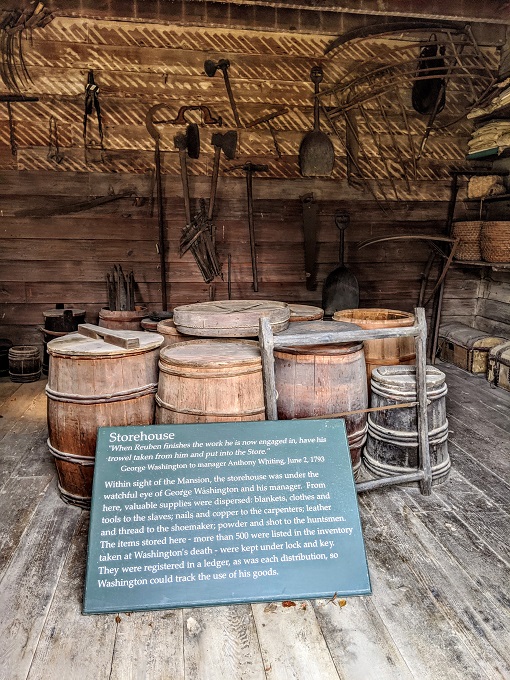
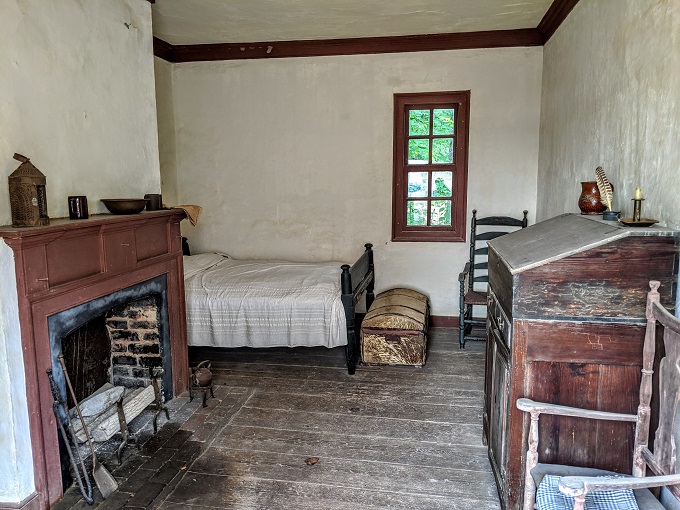
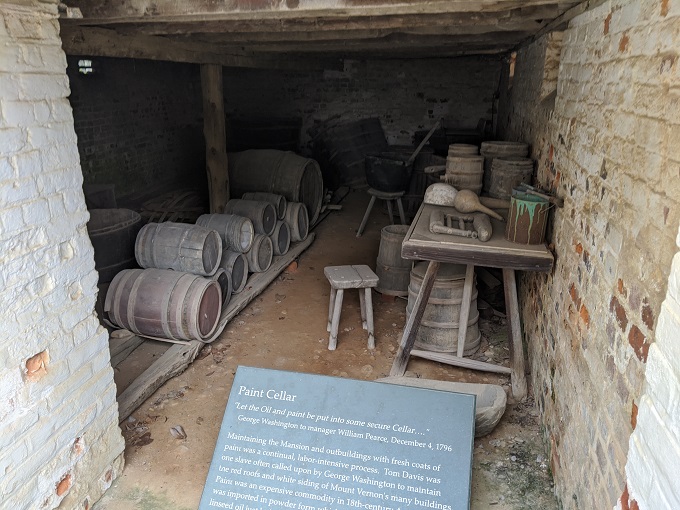
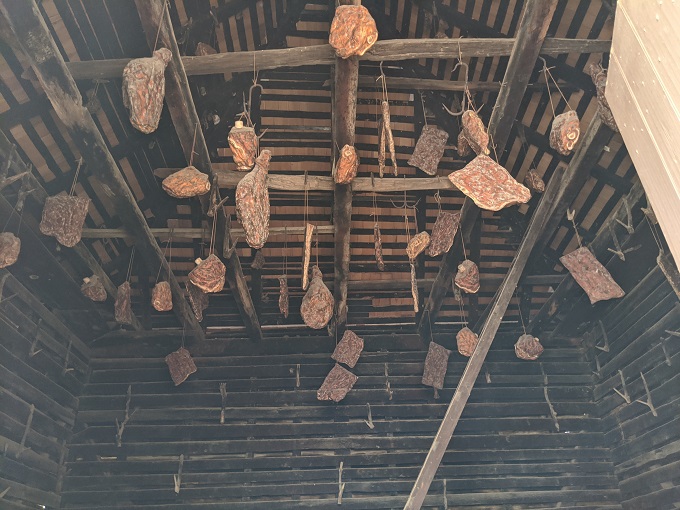
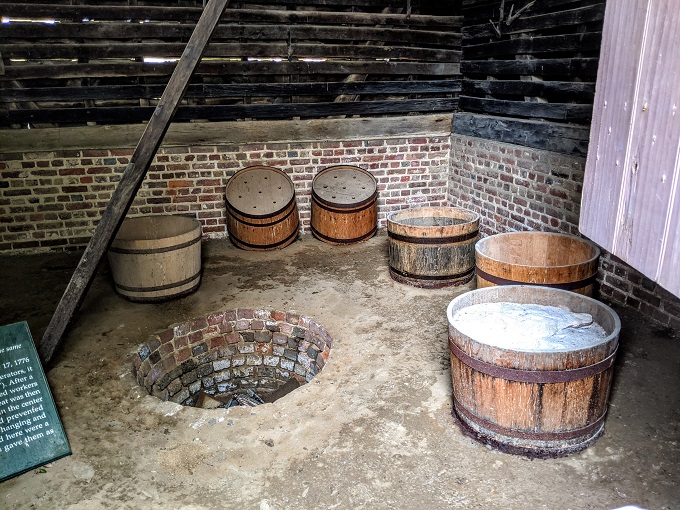
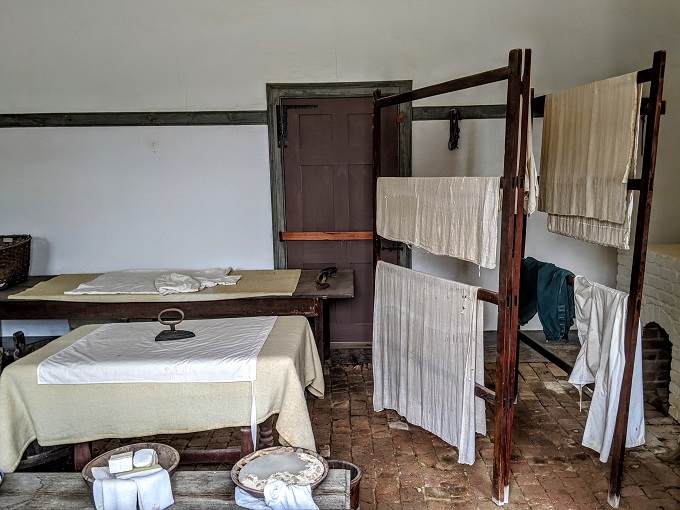
In addition to all the different buildings, there were a few live-action exhibits the day we visited, including this person working in the Blacksmith shop.
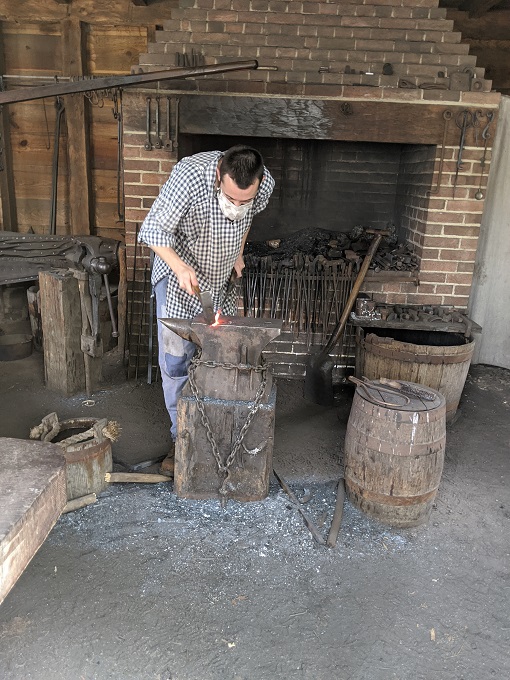
There’s so much more to Mount Vernon than just its buildings though. The estate covers dozens of acres, so once we’d checked out all the buildings we took a wander around the grounds as there was a lot more to see.
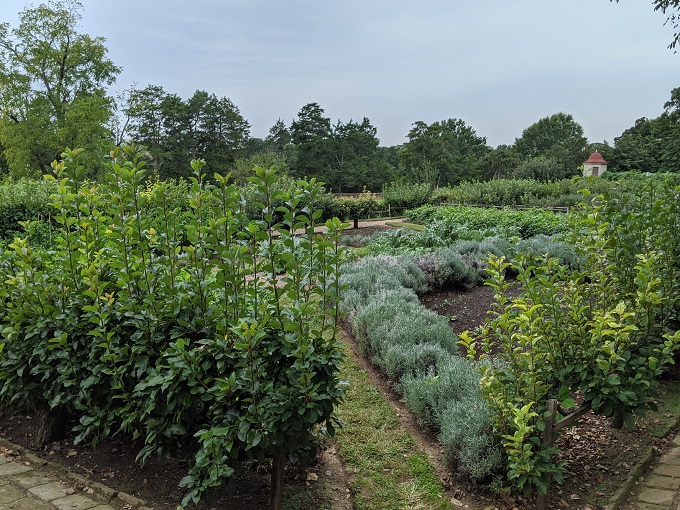
Washington lived in pre-car days, so when traveling the local area he would sometimes take advantage of being pulled by this riding chair. While it doesn’t look particularly glamorous, it traversed the terrain more easily than standard carriages.
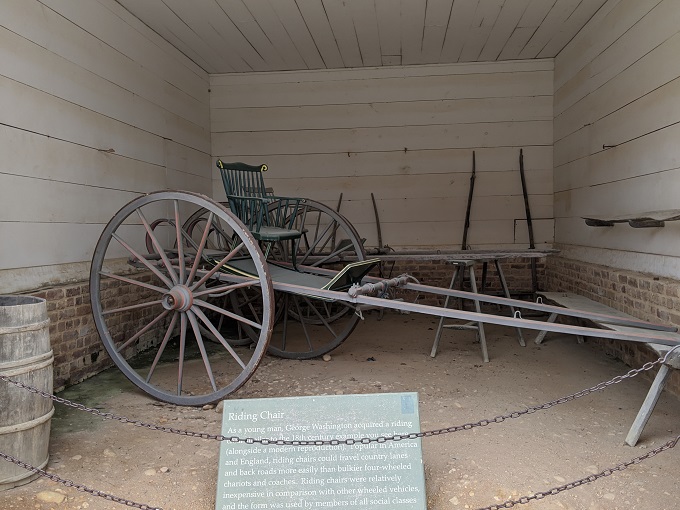
That’s not to say that he didn’t avail himself of carriages too though.
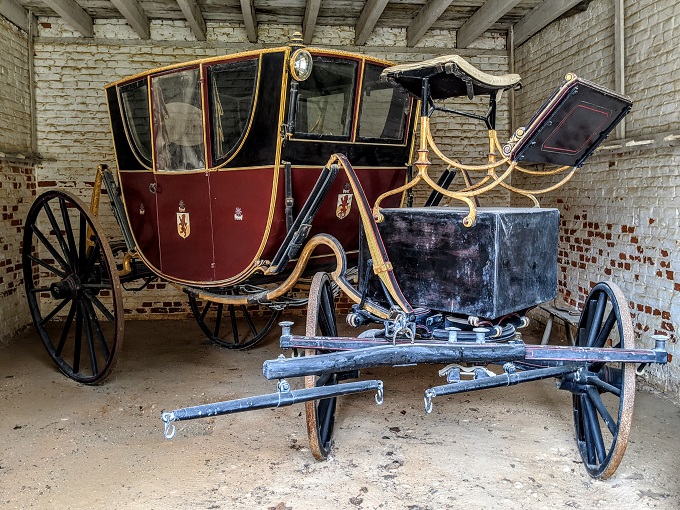
A significantly less glamourous – but vitally important – part of Mount Vernon was the dung repository. This was used to compost animal manure and organic materials to create fertilizer for the orchards and gardens.
The original building was built in 1787, although this was reconstructed in 2001. The dung repository at Mount Vernon is the earliest known example of a building dedicated to composting.
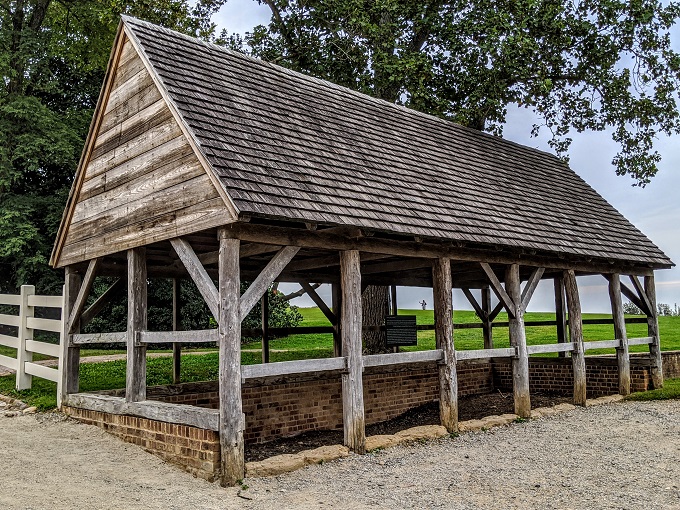
While walking around the grounds, we came across these ha-ha walls. They were constructed to keep grazing animals in their pastures so that they wouldn’t find their way up to the house.
No one is sure why they’re called ha-ha walls, but it’s thought it could be based on the surprised reaction of visitors when they came across them because the walls can’t be seen from the other side.
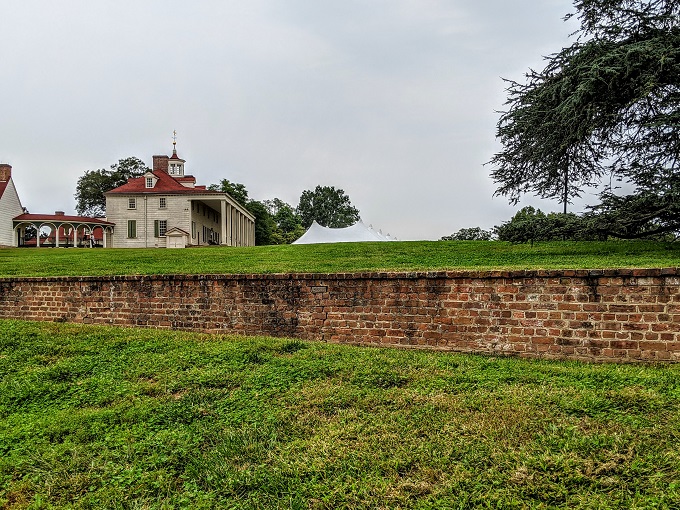
In addition to not having air conditioning or cars, George Washington also lived pre-electricity (well, pre humans using it for their own purposes). That meant they didn’t have fridges or freezers, so meat was cured and smoked to help preserve it.
Washington was able to take advantage of ice at times though. Being on the banks of the Potomac, the river would freeze over in winter.

He therefore designed an icehouse to store ice from the river. A well was dug into the hillside, insulated with straw and encased in wood. The well was fairly deep, so a 10 foot ladder was placed inside to enable enslaved workers to retrieve ice when needed.
Getting the ice from the river to the icehouse was hard work though. During the winter, all available enslaved people at Mount Vernon had to go down to the river to cut as many blocks of ice as they could before it thawed. They then had to drag the ice blocks back up the steep hill for them to be stored in the icehouse, all so that Washington, his family and guests could have cold drinks and ice cream.
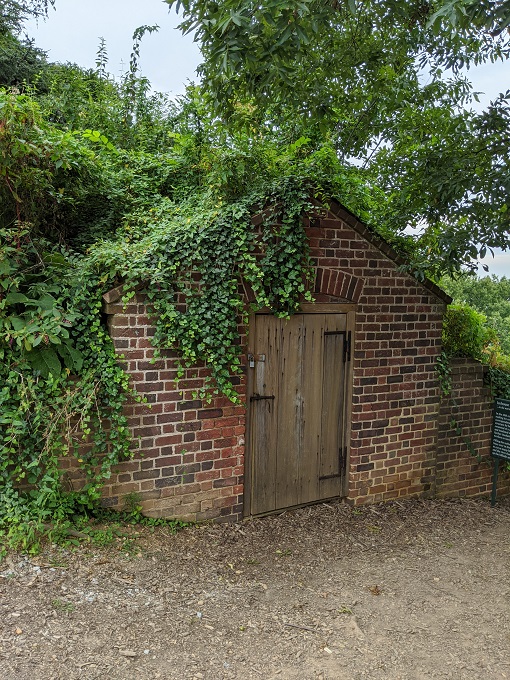
While wandering the grounds you’ll likely see – and possibly smell – some farm animals like horses and sheep.
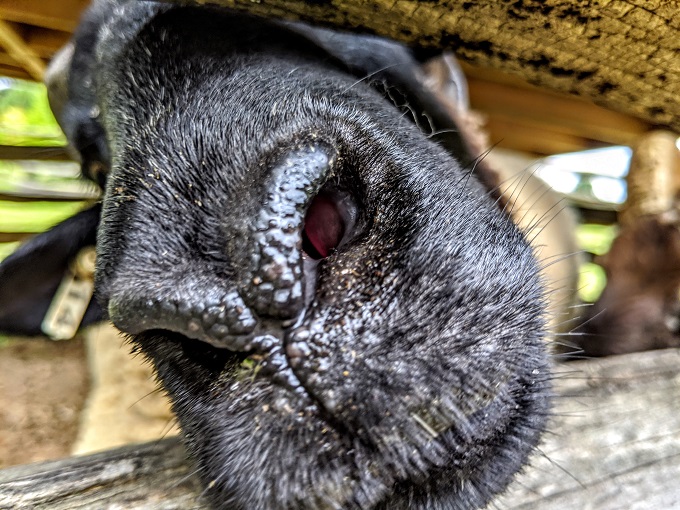
Our wanderings then brought us to a memorial to George Washington which is like a small version of the Washington Monument.
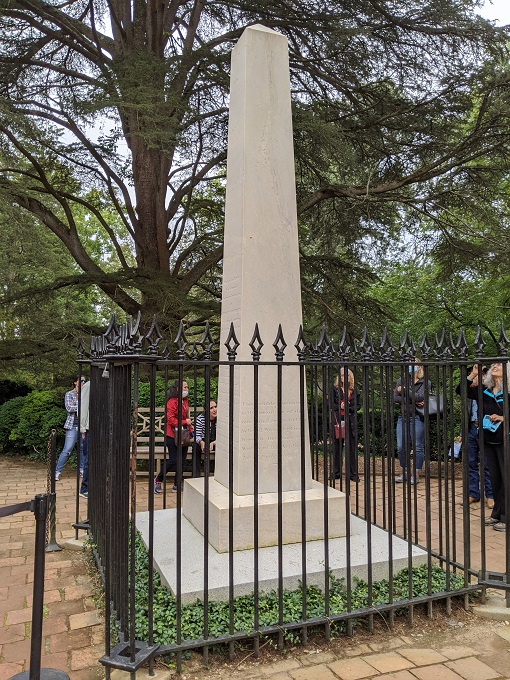
The memorial is located next to the tombs where George and Martha Washington were laid to rest.
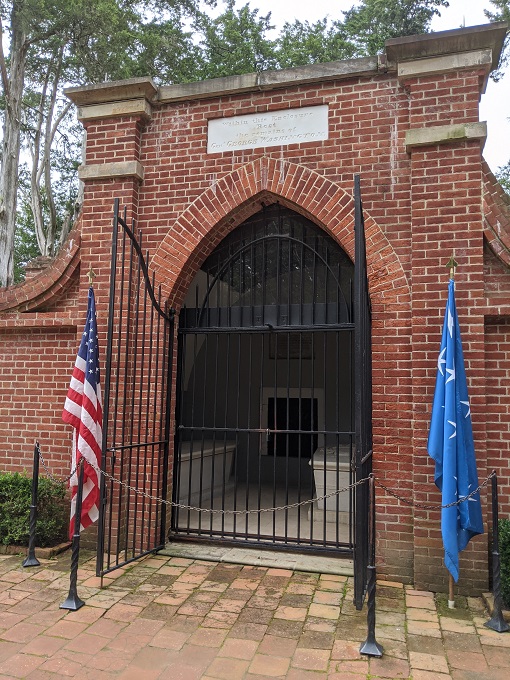
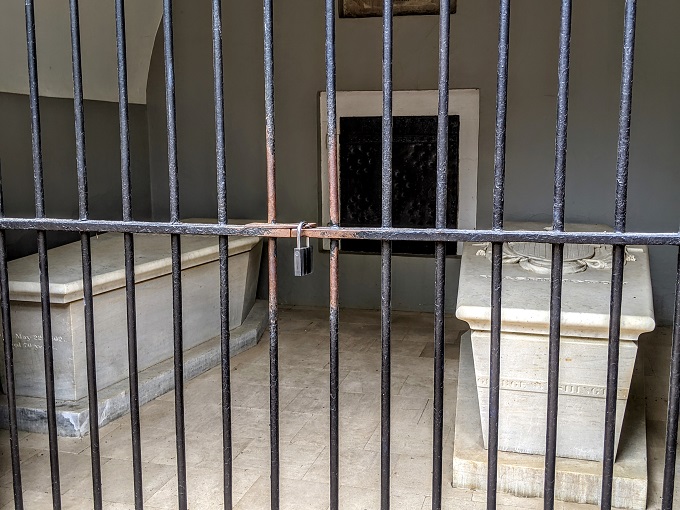
The Mount Vernon estate was built on the backs of enslaved people and they appear to be trying to do more to address that part of the site’s history. There’s a museum in the main building when you arrive which shares more about some of the enslaved people who were kept at Mount Vernon; photos aren’t allowed of those exhibits, so I don’t have any pictures to include in this post of that part of the site.
Out on the grounds though is a memorial to enslaved persons. A marker was erected in 1929 to note where a slave cemetery was located, but in 1983 a new memorial was dedicated in that area in memory of them.
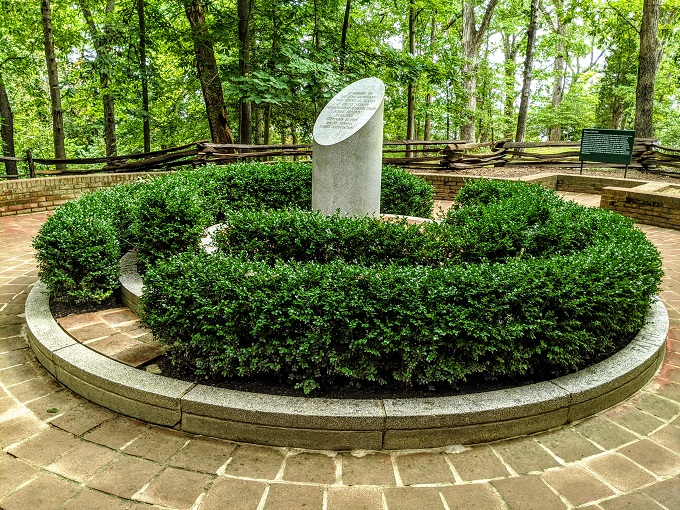
With Mount Vernon being on the banks of the Potomac River, we continued along a trail down to the river. That took us to a ferry landing and wharf which had several information boards about how the river played a part in the daily life and general history of Mount Vernon.
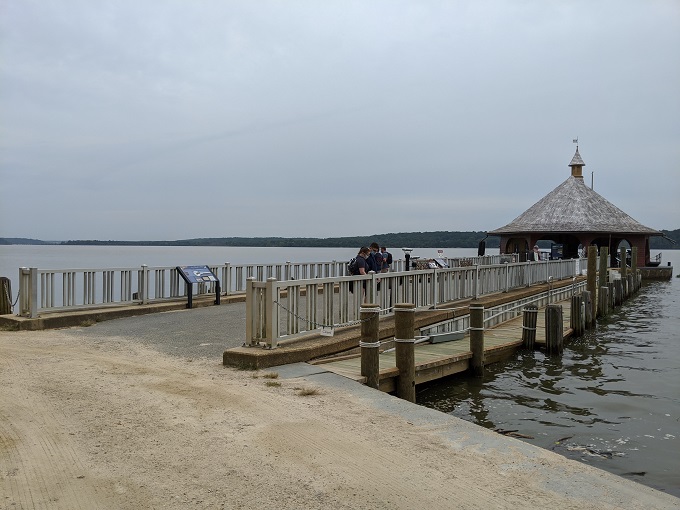
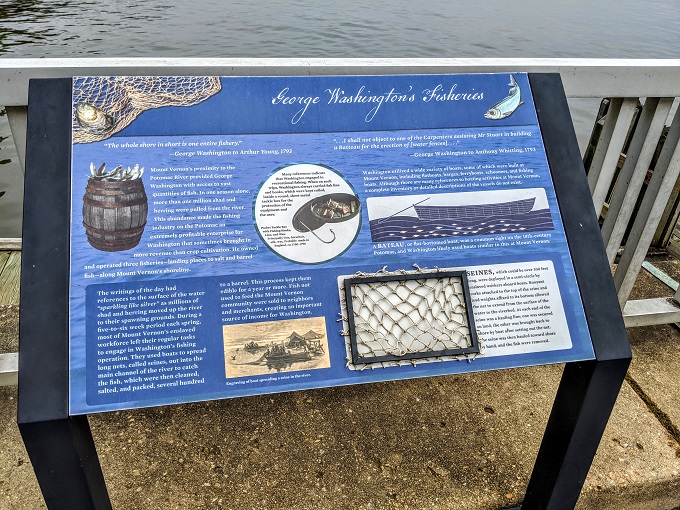
It’s a bit of a walk back uphill, so they provide a shuttle bus you can take back to the Education Center. Due to COVID, masks were required and some seats were blocked off, so capacity on the bus was limited. It didn’t seem busy when we visited, but we didn’t take it anyway as we wanted to continue walking to the next outdoor exhibit area.
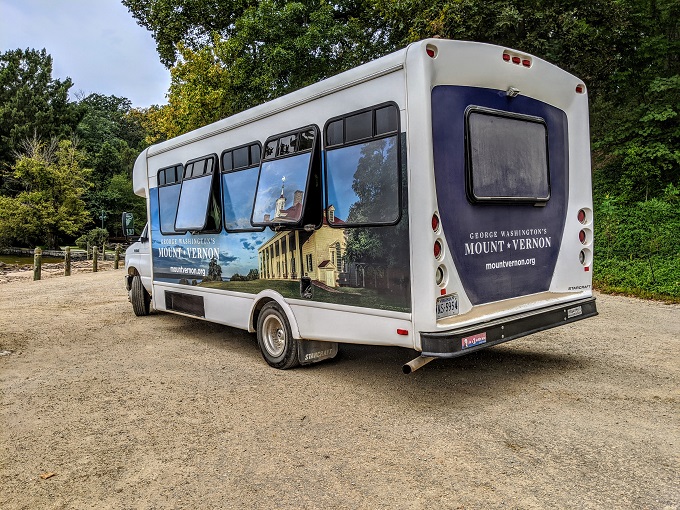
In addition to being the first President of the United States of America, George Washington was an avid farmer. He regarded it as incumbent that those with income and means helped progress farming techniques for everyone else, also believing that American prosperity would come about by trading its agricultural products overseas.
Mount Vernon was originally a tobacco plantation, but after tobacco was grown for four years, the soil was wrecked for 20 years afterwards. As a result, Washington moved from growing tobacco to wheat. This had the added benefit of not having conflict with the English over the tariffs being charged on tobacco.
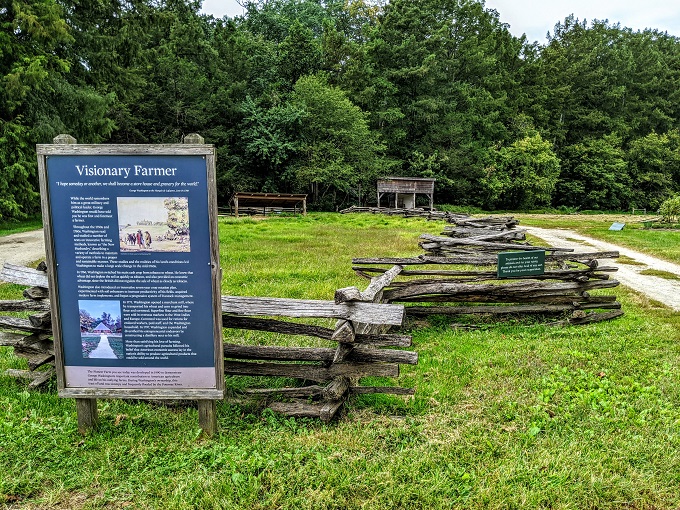
In addition to some information boards, there was a lady in period dress who shared more about George Washington’s farming techniques.
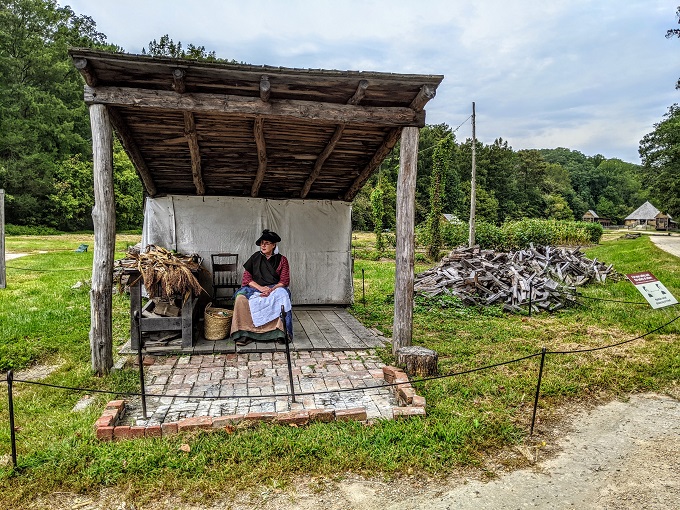
Washington took advantage of different fencing techniques for different purposes. Post and rail fencing was used to mark boundary lines and keep animals in specific fields where ha-ha walls weren’t appropriate.

Hurdle fencing was also used to keep animals in a certain area, although these fences were smaller and portable, so could be easily moved around the property.

Wattle fencing was used to keep poultry and small animals in, while keeping their predators out.
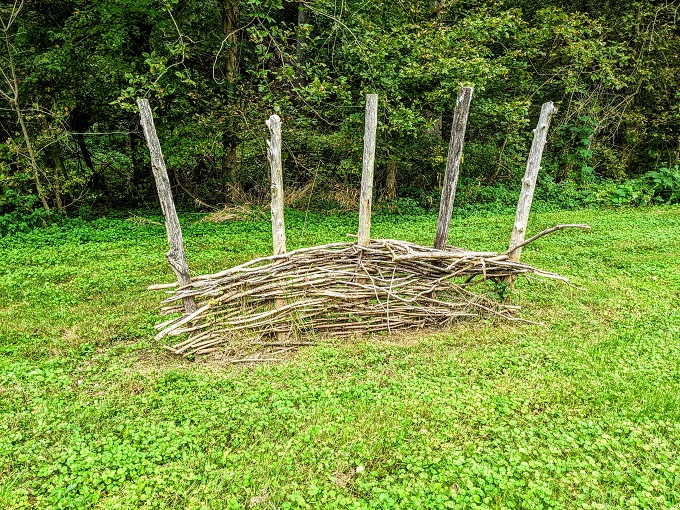
Split rail fencing meanwhile could be moved relatively easily and was used around fields. One of its benefits is that split rail fences could be built around obstructions like boulders and trees.
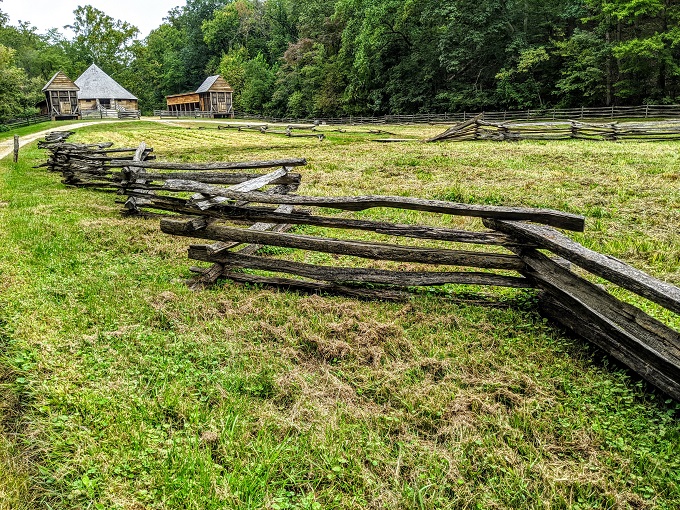
A little further along there was another person who shared more about Washington’s history as a farmer, explaining how a flail (pictured below) was used and how the President experimented with 60 different crops at Mount Vernon.
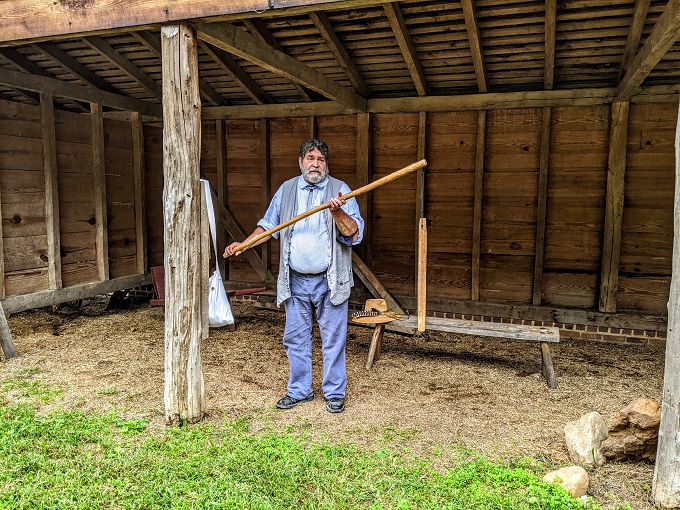
He also shared about the two story, 16-sided barn that George Washington designed to process and store grain. The barn was built between 1792-1795 and had a circular treading floor.
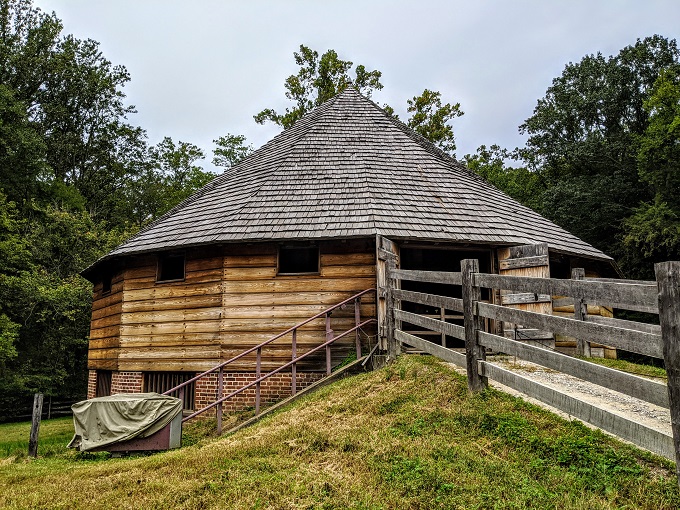
Wheat was laid on the floor, then horses were brought in and were sent trotting around in a circle. Their hooves knocked the wheat seeds through the gaps in the floorboards below, with Washington determining after much research that a gap of 1.5″ was optimal.
There were a number of reasons this was a clever design. First, the barn helped protect the grain from the elements; as the guy telling us about it explained, moisture is the mortal enemy of wheat.
If horses pooped while trotting along, by the time it made it to the bottom it would just be grass which could be easily picked out from the wheat. Far more cleverly though, horses are unable to urinate when moving. By keeping them trotting along, they were able to ensure that the mortal enemy – moisture – didn’t make it on to the wheat below.
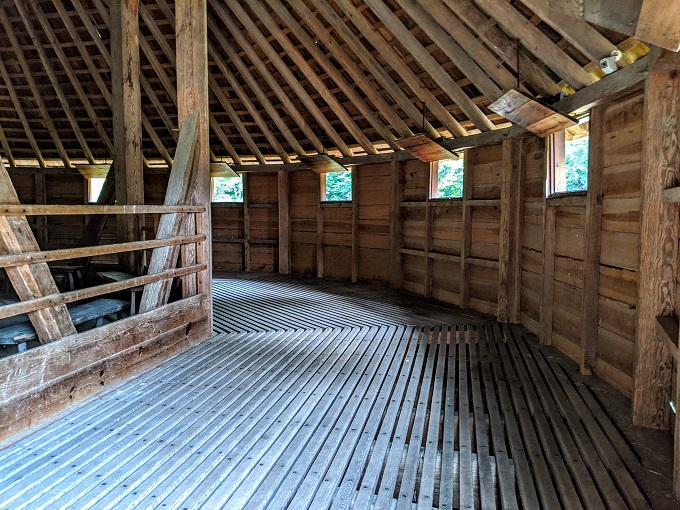
As we headed back uphill, we passed by a reproduction of what a slave cabin of the time would’ve looked like.
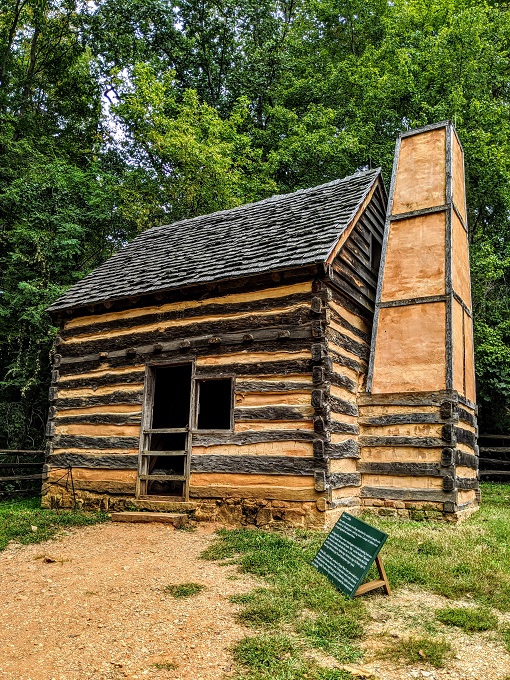
Mount Vernon once had about 40 cabins for enslaved persons on site. These housed one family per home regardless of family size, although on average 6-8 people would live in one of these cabins.
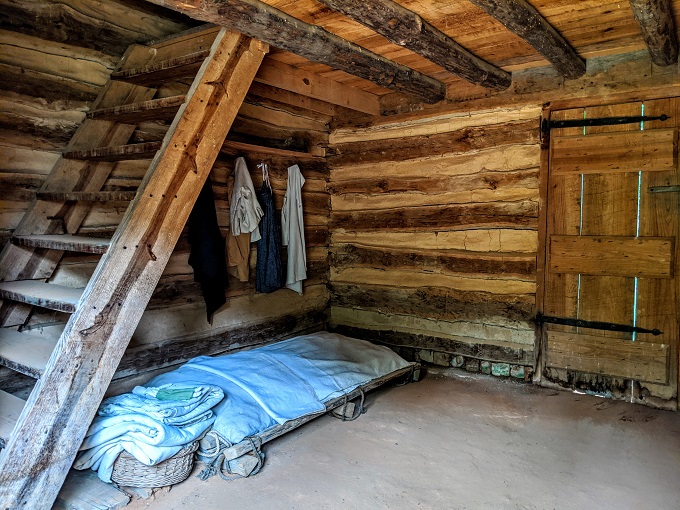
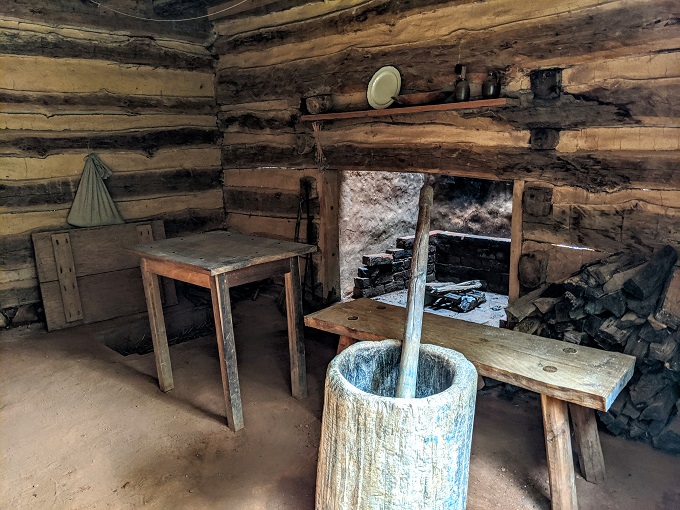
At this point it seemed like we’d pretty much seen everything on the grounds, so we started making our way towards the exit, grabbing a couple of photos near the mansion on our way.
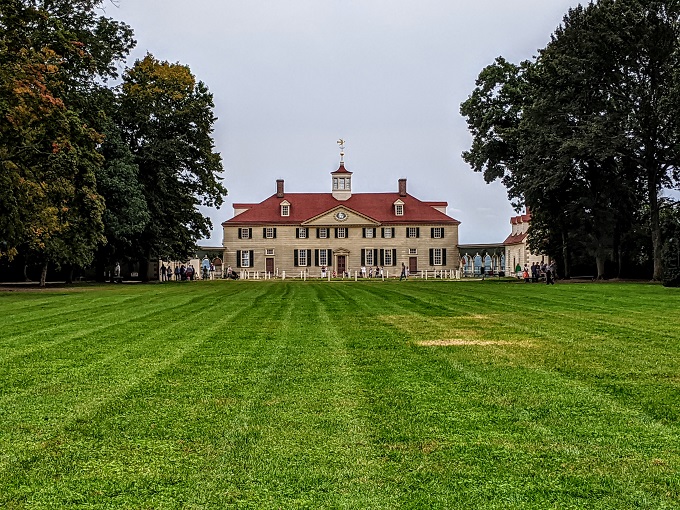
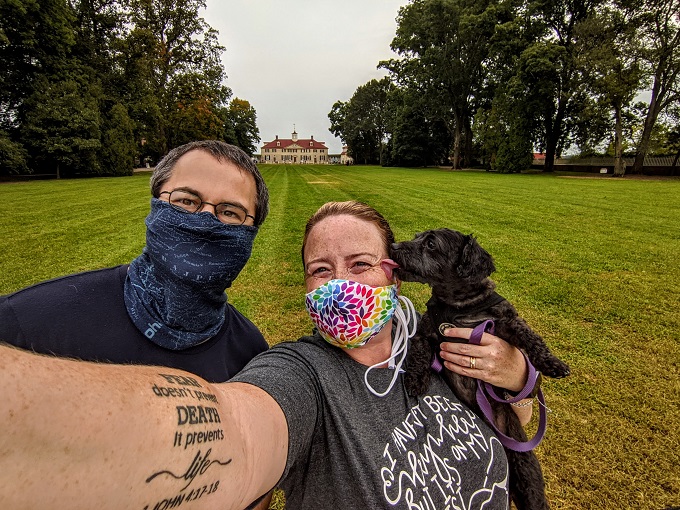
When arriving at Mount Vernon, there’s a Museum and Education Center at the entrance. We’d passed through here when arriving, but our timed passes for the Mansion tour meant we didn’t have time to stop to look at the time.
As mentioned earlier, the museum contained an exhibit dedicated to the enslaved persons of Mount Vernon called ‘Lives Bound Together’ – that was the area which didn’t allow photos.
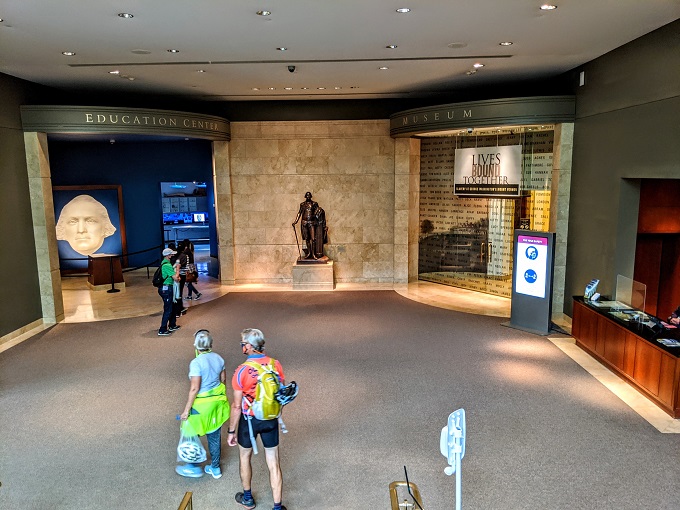
Next to the Museum was the Education Center which provided even more history about George Washington’s life. You have to go through the main building to get to the grounds and mansion, so Truffles was allowed inside, but she wasn’t allowed in the Museum or Education Center which was understandable.
We’d already been at Mount Vernon for four hours and you could easily spend 1-2 hours going through both the Museum and Education Center as there was so much to see, read and learn. Seeing as Shae and I would have had to take turns waiting outside with Truffles, we’d have been looking at another 2-4 hours there to do these sections.
As much as we’d have loved to take in all the additional information, we decided to head back to our hotel. Thankfully we knew that there was a specific exhibit on display in the Education Center, so we took it in turns to quickly head through there to see it.
I took a couple of photos while walking through to give you an idea of the displays inside.

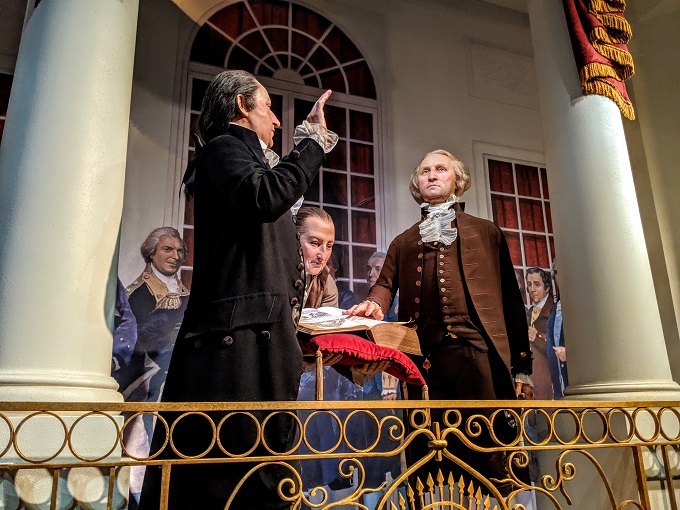
The exhibit we were seeking out was George Washington’s teeth. It’s commonly thought that Washington had a set of wooden dentures, but that’s not true. Instead, his dentures were made of a mix of materials including metal, cow and horse teeth, as well as human teeth, some of which were obtained from enslaved persons.
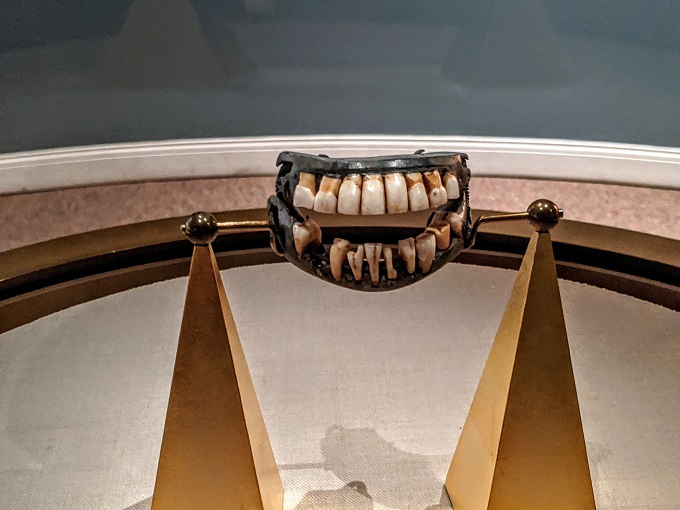
Final Thoughts
Shae and I (and Truffles!) really enjoyed touring Mount Vernon and learning more about the history of George Washington and his life there. We spent just over four hours exploring, but could’ve easily spent several more hours – especially in the Museum and Education Center.
It was also good to see that they’re doing more to address the history of slavery at Mount Vernon, seeing as the estate’s success was achieved primarily due to the work of enslaved persons over the years.
If you’re ever near northern Virginia or visiting Washington, D.C., I’d highly recommend taking a trip to Mount Vernon.
Ticket Prices
When we visited in September 2020, the cost of Grounds Passes for non-members varied in cost depending on what day of the week you visit:
- Adults – $21-23
- Children (6-11) – $10-12
- Children (0-5) – Free
Members of the U.S. Armed Forces, veterans, first responders, nurses and medical professionals are eligible for a $4 discount on Grounds Passes.
Tickets for a tour of the Mansion were an extra $2 per person (including for those ages 0-5) and are definitely worth that small additional investment.
Address
3200 Mount Vernon Memorial Hwy, Mt Vernon, VA 22121
[…] in to the John Dickinson Plantation. It wasn’t as grand as others we’ve visited like Mount Vernon, Monticello or Evergreen, but it provided another story to […]